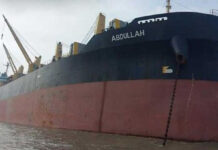
The FR Tower in flames on March 28. — New Age
AFTER the loss in the Chawkbazar fire that took place a little over a month, we are again stunned at seeing the FR Tower fire at Banani on March 28. This time, fire occurred in a different place close to a diplomatic area where we usually feel safer than in other places of the city. It was a 23-storey building in a commercial area surround by a lot of high rises, leaving a minimum space to move on, and the densely-packed place that houses many offices and several restaurants. The fire incident at Banani has already claimed 26 lives where the victims died mostly either from suffocation because of extreme smoke or died in an attempt to escape from the fire, falling from the upper floors of the high rise.
It was not as grave as the recent fire that took place in Old Town of Dhaka in terms of taking toll on lives. Yet, it raises several questions and forces us to rethink our activities in planning, monitoring, and managing the risks associated with fire and to deal with them accordingly. Before going through the complete investigation by several investigation committees, the fire officials found that there were no proper fire exits in the building and there was an insufficient fire-fighting equipment and it was not in a working condition. Moreover, the building’s two exits were too narrow for people inside to leave smoothly and were blocked by obstructions that made the task harder as well as the building was illegally extended upwards by several floors.
A 2012 study of Bangladesh University of Engineering and Technology reveals that most of high rises in Dhaka city have inadequate fire safety measures. Additionally, fire safety measures in those buildings were very weak, there were no sprinklers and the fire exits existed only in name. Moreover, in several inspections, it was found that the fire stairs had been blocked with stored goods and the exit doors locked.
In the Banani fire, we noticed that the blaze originated from a single floor and then it engulfed several floors and, finally, the flames approached the façade of this high rise, causing serious smoke and massive heat flux to give it a deadly shape.
This kind of façade fire usually takes a shattering shape and causes serious damage when it happens in a high rise like the FR Tower. We remember the fire incident of the high rise Grenfell Tower in London during 2017 which killed 79 people and wrought a psychological impact on urbanities all over the world living in densely packed cities. The investigation explored that the blaze intensity was enlarged because of the cladding materials installed to the residential façade blocks which added fuel to the flames.
Actually, the fire safety issue of high rise facades is a complex problem; therefore, only the use of prescribed fire codes is not enough to ensure a proper building fire safety level and, thus, it requires a complete approach. It includes a careful and responsible building design with a focus on performance, followed by rigorous execution and maintenance. It also contains early detection and suppression systems as well as prevention measures based on awareness and evacuation training.
Compared with the normal fires, the fire behaviour in high rises has some special features — (i) an extensive use of external facade insulation materials which poses new fire safety issues, (ii) specific fire evolution and smoke transport because of the complex building structures, (iii) structural safety of high rises during and after a fire hazard and (iv) human evacuation.
In recent years, exterior walls made of organic insulation materials, such as polystyrene and polyurethane, are widely used in high rises because of the demands for saving energy. However, these insulating materials are highly combustible and flames can spread very quickly and can produce huge smoke and toxic gas products once they burn.
Complex building structures also lead to specific fire evolution as the existence of a stairwell, elevator shaft, tube well or other special structure in the high rise usually cause a stack effect and piston effect during the fire. This contributes to a quicker spread of fire and the smoke transport inside the building passage becomes difficult.
Another aspect is the possible rupture of glass materials from curtain walls. The fire can emerge from the broken window and cannot be easily controlled. Fire also brings threats to the structures of high rises. Major structures such as glass curtain walls and steel structures lead to a very complex mechanical load distribution. The key components and nodes in the structure system are likely to fail or may even lead to the collapse of the entire building because of non-uniform heat fluxes in a fire. Once this happens, a secondary disaster could occur.
Finally, human evacuation in high rises in case of fire also becomes a major safety issue because personnel evacuation behaviour in high rises shows a complex and multi-directional characteristics and equipment. The inability of the occupants to smoothly and safely evacuate in case of a fire at medium and high-rise buildings poses a serious threat.
Thus, the conformity to fire safety measures is unquestionably important while one also wonders whether it is possible to be completely safe in case of such a fire incident.
The most effective solution to avoid such situations is to come up with a realistic and a holistic approach:
— Taking proper passive fire protection: This includes appropriate building design like adequate escape routes, compartmentation to curb the fire spread and to protect the structural integrity.
— Adopting active fire protection system: This means early detection and suppression systems, including the installation of automatic sprinklers in the building or having fire extinguishers and smoke alarms readily available on all floors which can be very effective in fire protection at high and medium-rise buildings.
— Through prevention: The fire safety level of high rises can be improved by assigning responsibilities to relevant professionals from planning, construction, and maintenance department and choosing materials with minimum fire risks. Mandatory fire drills and awareness campaigns are also a very effective tool in improving fire safety within buildings and providing evacuation training for its occupants.
Moreover, identifying buildings with external cladding that failed to meet fire safety standards and combustible facades can help to head off tremendous loss of life and property during this kind of fire accident in the near future.
Dr Engineer Chanchal Kumar Kundu is a postdoctoral research fellow at the Engineering Research Centre for Nanomaterials (Fire Group) of Henan University, China and assistant professor at the BGMEA University of Fashion and Technology, Bangladesh.
Source: New Age.









